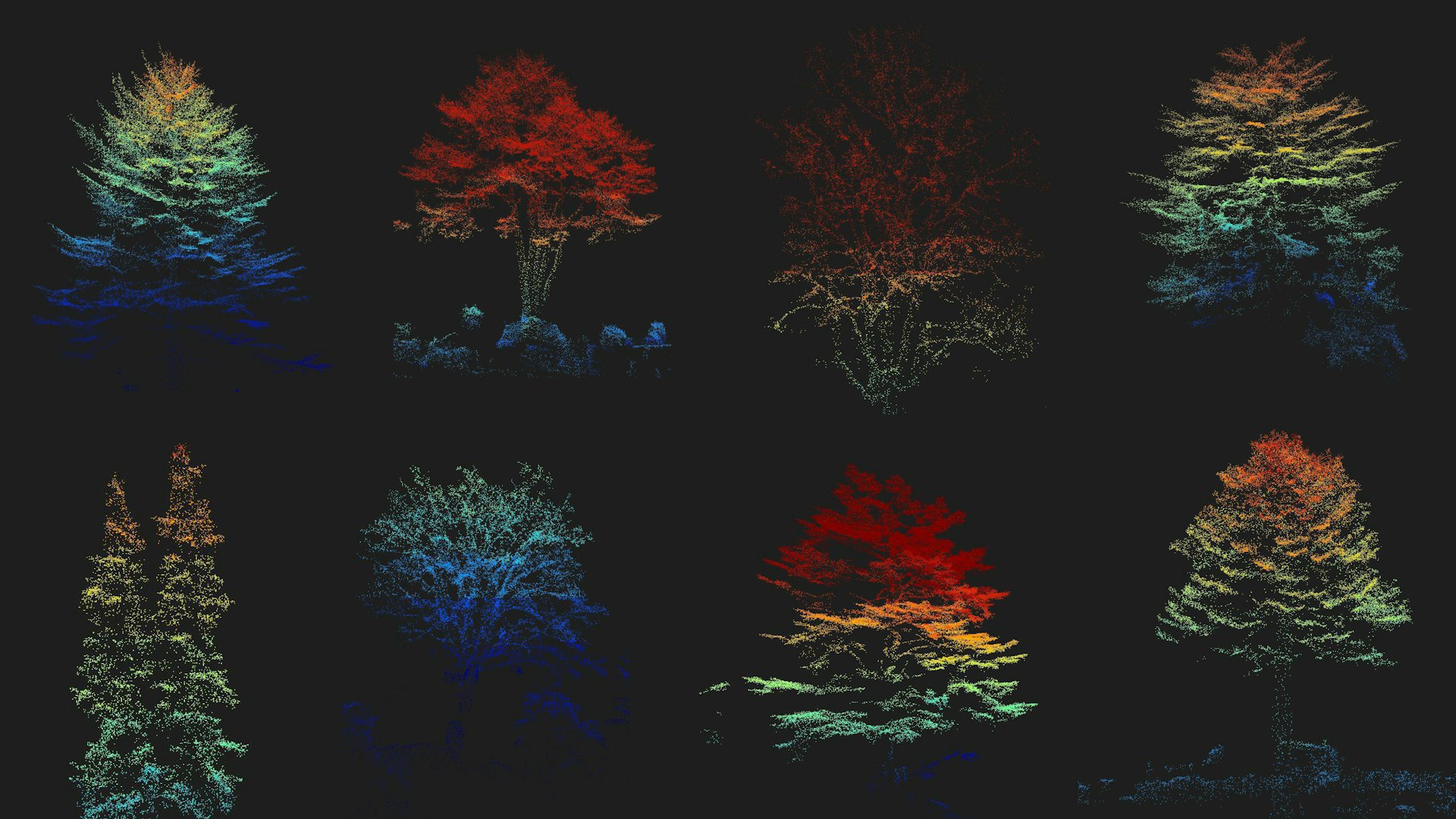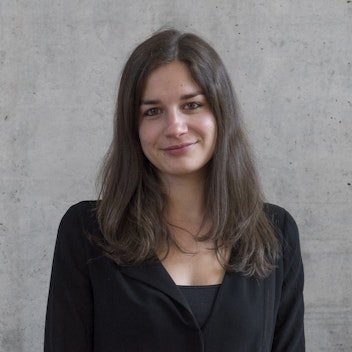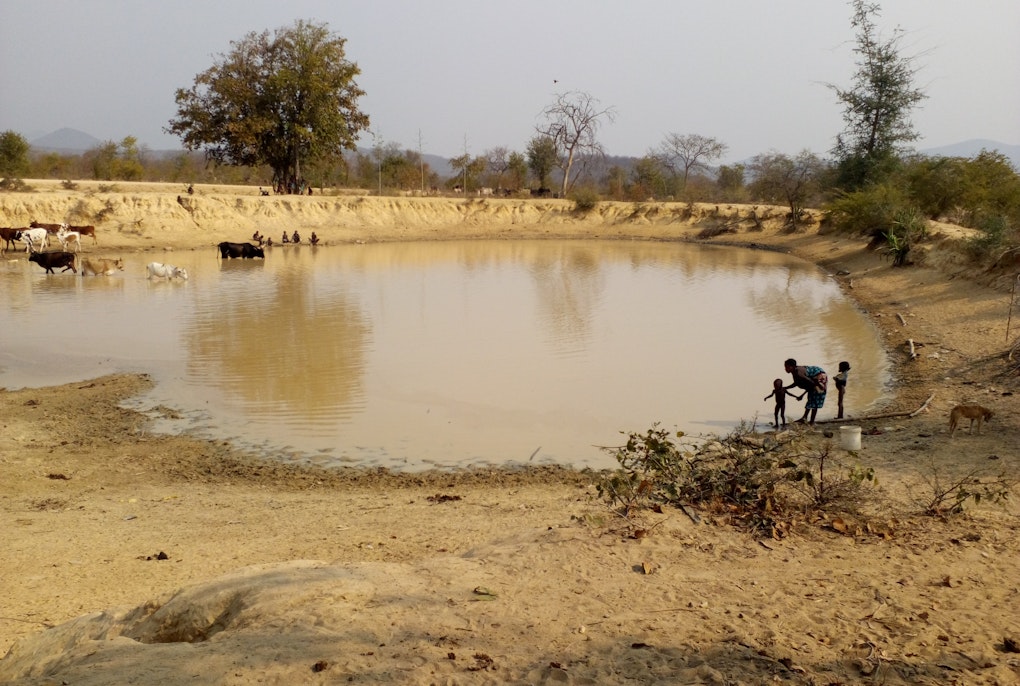magazine_ Article
A portrait of every tree
How the city of Merano is using new technology to protect its old trees
“Digital“ twins of Merano’s trees: The data from an aerial laser survey provides a wealth of information for each tree - location, the total as well as crown height, circumference and surface area. All of the city’s trees, both public and private, will be recorded in the digital tree cadastre.
Photo: TS Photogrammetrie & Geoinformatik | All rights reserved
They cool down the environment, improve the air, prevent flooding, and provide homes to many species. In times of climate and biodiversity crisis, cities must care more than ever about preserving their trees. To do this, the city of Merano is relying on new technology - and a new awareness.
On two consecutively clear days in February this year, a helicopter circled about 400 meters above Merano to use a special laser technique (LiDAR) to measure the city's most beautiful feature: its historic tree population. More than 200 species grow in the city, including many exotics - a legacy of Merano’s spa history that attracted aristocracy and bourgeoisie from all over Europe in the late 18th century - when plants were shipped in from all over the world. Many of these trees are over a hundred years old, the oldest over 150. Depending on their location, their exposure to urban impositions such as soil compaction, exhaust fumes, road salt, dog urine, varies. One thing does unite the trees of Merano: all of them are having to endure the greater heat and longer periods of drought that climate change is bringing. These trees need a lot of attention and care, and the 8000 or so that grow on city-owned land have received both in recent years. “We know every public tree very well,” says forester Anni Schwarz, the former director of the city’s horticulture department who was long responsible for looking after the city’s trees. Now Schwarz has taken over the management of the JUSTNature project as a technical officer. The project, funded by the EU's Horizon Program, delves deeper, seeking to know the city’s privately owned trees more precisely to better protect them. The laser scan from a helicopter was the first step.
In the EU JUSTNature project, pilot cities throughout Europe are working to create better living conditions for everyone through “nature-based” solutions. The fact that Merano is also focusing on private trees in the process is “interesting and important,” says Eurac Research biologist and spatial planning expert Sonja Gantioler, who is coordinating the entire project. “Usually, nature-based solutions are discussed mainly in relation to public spaces. In some cities, however, most green space is privately owned.” In the case of Merano's green space, it’s a good two-thirds. But how many trees are there in private parks and gardens? What type and size are they? And who are their owners? Answers to all these questions will be available once the huge amount of LiDAR data has been evaluated – the data covers a point cloud as large as the entire area of Merano. Ideally, the aim would be to create a similarly complete inventory of the private trees as the one the city already has of the public trees in its tree cadastre. This catalogue contains the “identity cards” of the city’s public trees and will be very helpful in identifying its private ones too.
One to two hundred particularly valuable trees will then be filtered out of the huge number of private trees in order to have their health expertly assessed with project funds. Once this has been undertaken, experts will decide if any measures are necessary – whether dead wood needs to be removed or a branches need to be secured, for example. Thanks to the LiDAR data, each tree in the city will have a “digital twin”: a digital 3D representation that shows the tree’s its position and characteristics.
At some point, these twins might even serve as a kind of “laboratory” on which changing conditions can be simulated and the effects observed, Gantioler explains. The images will be of immediate use to the Landscape Commission, for example, in order to get a true picture of the situation when it has to assess construction projects: Are there really only three small trees, as the project manager claims, or are they magnificent specimens? Although details on private green space may be fuzzy, one thing has been clear for a long time: the pressure to build up is enormous. “The city is very attractive; it is growing, but it should not grow beyond its limits because if it does, the spaces for living will get more crowded and green spaces will get lost.” explains Schwarz.
The increasing existential importance of trees for today’s cities
To what extent it will be possible to identify all Merano’s trees remains to be seen. Palm trees are very easy to identify, with cedars, which often have several crowns, it’s less simple. What can be determined very accurately, however, are the crown height and crown diameter of each tree, as well as tree height and trunk thickness. “These parameters are good indicators of “greening”, providing much more information than just the number of trees or the number of green areas,” Schwarz explains. “Using this data, I can better identify where in the city the trees need more attention. Where we need to do something.”
Greening is, after all, of increasing existential importance to cities today, in addition to its obvious aesthetic value: green areas protect the climate because plants absorb CO2, and green mitigates the effects of climate change. Trees do a particularly good job. The shade of large treetops prevents stone and concrete surfaces from becoming extremely hot, the leaves provide cooling through evaporation, and because air flows from hot to cool areas, trees even create gentle breezes. All of this works to combat the notorious heat islands of urban zones. Flooding after heavy rains also becomes less likely because plants already absorb water above ground, and below ground, root systems improve the soil’s ability to store water. Trees filter harmful gases from the air and bind fine dust, are homes to birds, small animals and insects. Trees dampen street noise. In short, if life in the city is to remain bearable in summer, we need trees.
“The dominant feeling there is fear of responsibility.”
Anni Schwarz
But the trees can only save us if we save them. Merano recognized this earlier than elsewhere in South Tyrol and was the first city in the province to pass a tree protection statute in 2001. Since then, trees that measure more than 30cm in diameter at a height of one meter from the ground, can no longer be felled without permission. If felling is necessary, the lost trees must be replaced with suitable new ones. And “suitable” today means that they can cope with the conditions of climate change. Severe heat and water shortages weaken many tree species, making them more susceptible to disease. Cities whose tree populations consist of only a few species are not in a good position: if one of the species is attacked by disease, the city may lose a large part of its shade trees, which have grown over many decades, just when it needs them most – in one fell swoop. Merano, which received the international award for “European City of the Trees” in 2022 for successfully preserving its valuable tree population, is protecting the great diversity of its species from such a nightmare.
Not, however, from another risk of climate change: the increasing extreme events in which trees themselves can become a hazard. In 2019, strong gusts of wind damaged or uprooted several trees in Merano, injuring a mother and her child. “That was traumatic for the whole city,” says Schwarz, whose management of the city’s gardening department not only provided insight into gardens with magnificent old trees, but also into the owners’ states of mind: “The dominant feeling there is fear of responsibility.” She understands that fear well; after all, she was responsible for thousands of trees. “When you have an old cedar standing in front of your house and you see how it leans back and forth during storms, it can be enough to make you lose sleep.”
That’s why, she says, the central goal of the project is to help tree owners - and in a much broader sense than through the free appraisals which in any event are limited by the budget only being available for the next three years. “Above all, it's also about showing more appreciation for the owners of the trees themselves who are doing enormously important things for the community by taking care of these trees - a service that involves costs, work and, indeed, responsibility.”
But instead of receiving recognition, tree owners are often even subjected to “hostility,” according to a press release from the city of Merano. This could be because of the leaves in the fall, or because the shade that is welcome in the summer is less welcome in the other seasons. Added to this is the conflict with photovoltaics, says Schwarz.
Faced with these challenges, Merano wants to create a new awareness, instead of dark forebodings and evil glances from neighbours, people should be proud of the trees in their gardens and the contribution they make to the urban quality of life, says Marco Masin, the new service manager of the city’s horticulture department. There are already ideas about how to strengthen this feeling, for example through organized tours of particularly valuable private trees or through tree sponsorships.
Another possibility is to publish the digital twins on a platform for the co-governance of green space, as is currently being developed within the framework of JUSTNature, explains Gantioler: “Anyone who wants to, should be able to take responsibility for a piece of green space and help shape it. People could also get involved in this way for specific trees.” That would be a further step: an innovative implementation of the beautiful idea that trees, no matter where they are,concern everyone.
 technical documentation
technical documentationJUSTNature: an EU project
Coordinated by Eurac Research, 20 European partners are investigating what a transition to more climate-friendly cities might look like in a five-year research project. In seven cities with different climatic, social and economic conditions - from Leuven in Belgium to Gzira in Malta – “nature-based solutions” are to be implemented. The aim is to contribute to better air quality and lower emissions; in addition, the solutions should also improve access to ecological spaces, especially for population groups that have been disadvantaged in this respect up to now. In South Tyrol, Bolzano and Merano are project https://justnatureproject.eu/









